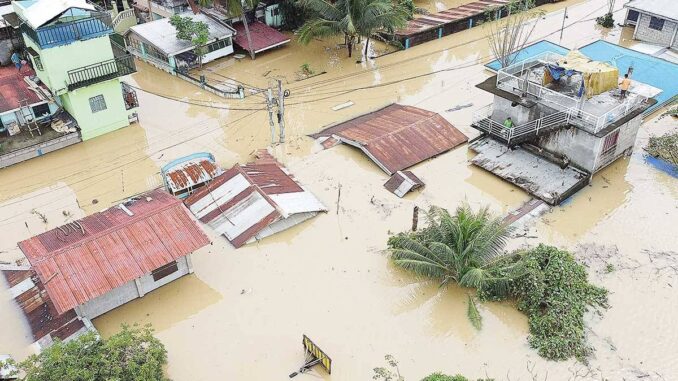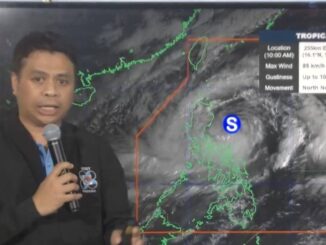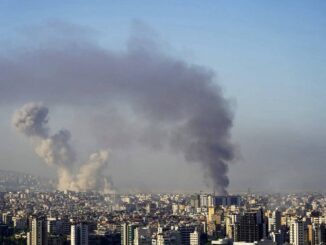
FLOODWATERS submerged hundreds of houses in the northern Philippines on Monday after water released from the Magat Dam following Typhoon Pepito caused the Cagayan River to break its banks.
Packing maximum sustained wind speeds of 185 kilometers an hour, Pepito slammed into Catanduanes island late Saturday and the main island of Luzon on Sunday afternoon.
The sixth major storm to batter the Philippines in a month dumped heavy rain, smashed flimsy buildings, knocked out power and claimed at least eight lives.
PEPITO’S DOING An aerial view shows submerged homes at a village in Ilagan, Isabela province, on Nov. 18, 2024, due to continuous heavy rains from Super Typhoon Pepito. PHOTO BY VILLAMOR VISAYA/AFP
The national weather service had warned of a “potentially catastrophic” impact from Pepito, which was a super typhoon when it hit, but President Ferdinand Marcos Jr. said Monday it “wasn’t as bad as we feared.”
But as people cleaned up on Monday, floods began hitting communities in the north after water from Magat Dam was released, causing the Cagayan River and some tributaries to overflow.
Rooftops could be seen poking through brown water in Ilagan city in Isabela province, while buildings and roads near Tuguegarao City in Cagayan province were inundated.
“If Magat Dam continues to release water on all of its seven gates, Ilagan city might get erased from the map due to flooding,” Jun Montereal, chairman of the city’s disaster preparedness committee, said, estimating 500 houses had been flooded.
“This is one of the gravest incidents that we have ever experienced because of the typhoon.”
Carlo Ablan, who helps oversee operations at the dam, said water was released after a “huge volume” of inflows due to rain from Pepito.
“If we won’t be releasing water, the worst possible scenario will be our dam would collapse, and that will be a much bigger problem,” Ablan said.
Four major dams in Luzon had a total of 18 gates opened to release water in a bid to avoid an overflow, the state-run weather agency said on Monday. Aside from the Magat Dam, the Ambuklao Dam in Bokod, Benguet, had eight gates unlocked, while the Binga Dam in Itogon town has been releasing rainwater through its six gates. The weather bureau said one gate was also opened at San Roque Dam in Pangasinan province.
Heavy damage
At least eight people were killed when Typhoon Pepito slammed into the islands over the weekend, including a 79-year-old man, who died in Camarines Norte after his motorbike was caught in a power line, police said.
Seven people died and three were injured when a landslide buried their house in Nueva Vizcaya province in Luzon, Kristine Falcon of the provincial disaster agency said.
Power outages across the island province of Catanduanes could last for months after Pepito toppled electricity poles, provincial information officer Camille Gianan said.
“Catanduanes has been heavily damaged by that typhoon — we need food packs, hygiene kits and construction materials,” Gianan said.
“Most houses with light materials were flattened while some houses made of concrete had their roofs, doors and windows destroyed.”
In the coastal town of Baler in Aurora province, cleanup operations were underway to remove felled trees and debris blocking roads and waterways.
“Most of the houses here are made of light materials so even now, before the inspection, we are expecting heavy damage on many houses in town,” disaster officer Neil Rojo said.
“We’ve also received reports of roofs that went flying with the wind last night… it was the fierce wind that got us scared, not exactly the heavy rains.”
The string of severe weather disturbances in the last couple of weeks — Nika, Ofel and Pepito — have affected a total of 1.15 million people in the Ilocos Region, Cagayan Valley, Central Luzon, Mimaropa, Bicol Region and Cordillera Administrative Region (CAR), the latest data from the National Disaster Risk Reduction and Management Council (NDRRMC) showed.
The Department of Social Welfare and Development (DSWD) put the estimated number of people affected higher, at 2.3 million in eight regions.
Some 104,830 families or 446,177 persons sheltered inside 2,717 evacuation centers and 66,681 families or 238,894 persons were served outside the evacuation centers.
A total of 272 road sections and 101 bridges were affected.
Some 7,838 houses were damaged in the Ilocos Region, Cagayan Valley, Central Luzon and CAR. Of these, 437 were destroyed.
The damage to agriculture is estimated at P8.64 million, while the cost to infrastructure was estimated at P469.85 million in Cagayan Valley, Central Luzon and CAR.
Some 11 cities and municipalities had declared a state of calamity.
Storm weakens
Pepito weakened significantly as it traversed the mountains of Luzon and was downgraded to a severe tropical storm as it swept over the South China Sea toward Vietnam on Monday.
The Philippine Atmospheric, Geophysical and Astronomical Services Administration (Pagasa) said Pepito had exited the Philippine area of responsibility (PAR) days after it made two landfalls, whipping many parts of Luzon and Visayas.
As a result, Pagasa said it lifted all storm signals in many areas, including the provinces of Catanduanes, Isabela, Aurora and Nueva Vizcaya, where Signal No. 5 was raised.
Climate change is increasing the intensity of storms, leading to heavier rains, flash floods and stronger gusts.
At least 171 people in the Philippines died in the past month’s storms, which left thousands homeless and wiped out crops and livestock.
About 20 big storms and typhoons hit the Philippines or its surrounding waters each year, killing scores of people, but it is rare for multiple such weather events to take place in a small window.
Pepito also hit the Philippines late in the typhoon season — most cyclones develop between July and October.
This month, four storms were clustered simultaneously in the Pacific basin, which the Japan Meteorological Agency said was the first time such an occurrence had been observed in November since its records began in 1951.
In other storm-related developments:
– The Department of Energy (DOE) said on Monday that energy stakeholders have been conducting several restoration efforts to ensure the swift return of electricity services damaged by the various tropical cyclones. Energy Secretary Raphael P.M. Lotilla said teams of linemen, engineers, and technical personnel from electric cooperatives across Northern and Southern Luzon, including Aurora Province, and the Bicol Region, along with the National Grid Corp. of the Philippines (NGCP) and private distribution utilities, are working to bring power back to affected communities.
– President Marcos urged Filipinos to share their blessings with those still struggling to recover from the devastation left by recent typhoons as Christmas nears. “So, us Filipinos this Christmas, let us remember our countrymen who were devastated … Let us share whatever we can with them as they are in an unfortunate situation right now,” Marcos said during a chance interview in Malacañang.
– Twenty-four trucks carrying relief goods left the House of Representatives early on Monday morning for typhoon-hit Bicol. The House, led by Speaker Martin Romualdez, and the Department of Social Welfare and Development (DSWD), launched the relief initiative called “Tabang Bikol, Tindog Oragon.” Romualdez’s office said that the trucks contained food, hygiene kits, clothing, and other essential goods collected from a nationwide donation drive. Aside from relief goods distribution, the initiative also includes the distribution of cash aid under the DSWD’s Assistance for Individuals in Crisis Situations program. The payout, which is for over 150,000 beneficiaries, starts on Nov. 18.
WITH FRANCIS EARL CUETO, MOISES CRUZ, ED PAOLO SALTING, REINA C. TOLENTINO, WILLIAM B. DEPASUPIL, KRISTINA MARALIT





Be the first to comment